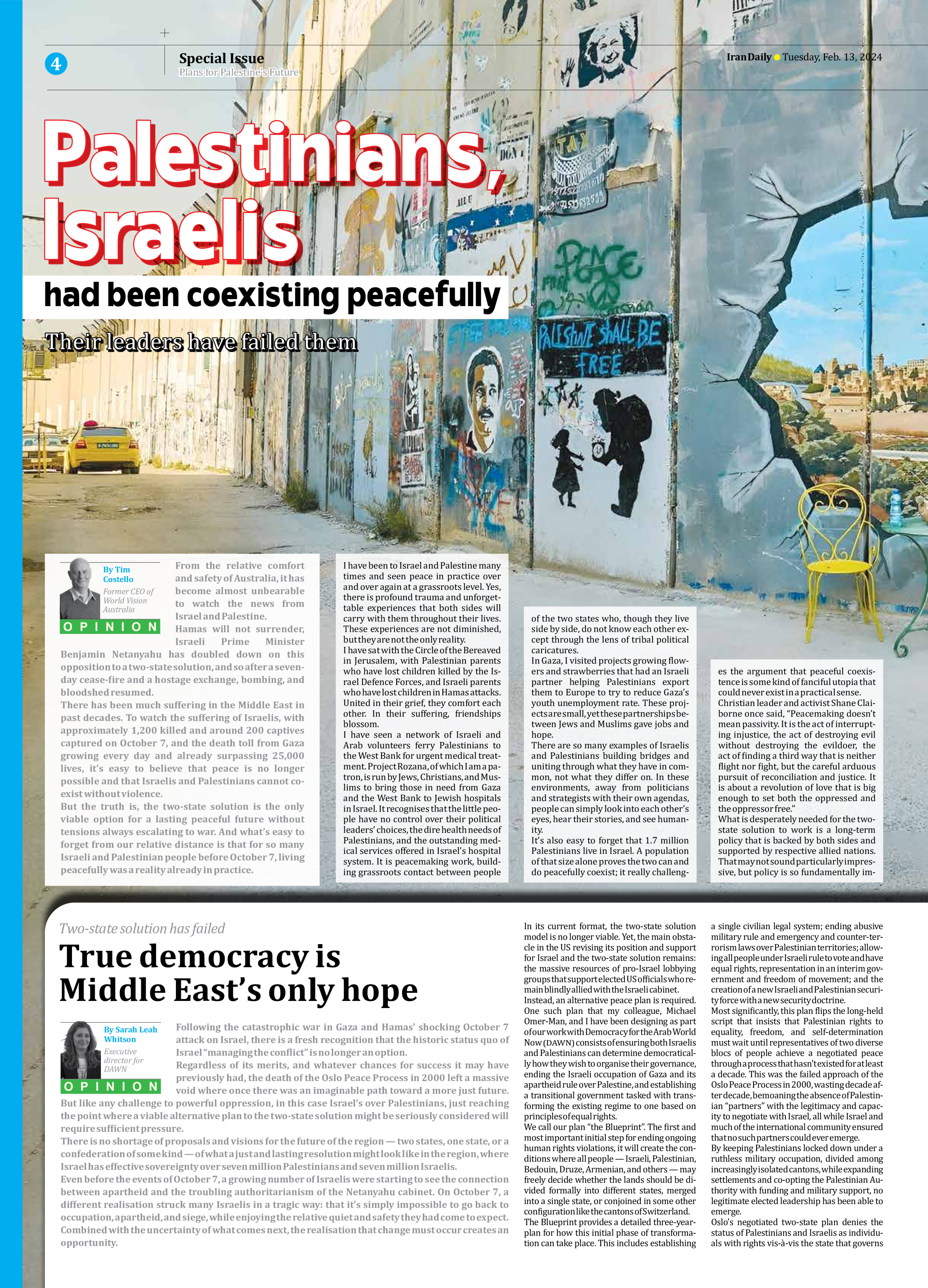
Two-state solution has failed
True democracy is Middle East’s only hope
By Sarah Leah Whitson
Executive director for DAWN
Following the catastrophic war in Gaza and Hamas’ shocking October 7 attack on Israel, there is a fresh recognition that the historic status quo of Israel “managing the conflict” is no longer an option.
Regardless of its merits, and whatever chances for success it may have previously had, the death of the Oslo Peace Process in 2000 left a massive void where once there was an imaginable path toward a more just future. But like any challenge to powerful oppression, in this case Israel’s over Palestinians, just reaching the point where a viable alternative plan to the two-state solution might be seriously considered will require sufficient pressure.
There is no shortage of proposals and visions for the future of the region — two states, one state, or a confederation of some kind — of what a just and lasting resolution might look like in the region, where Israel has effective sovereignty over seven million Palestinians and seven million Israelis.
Even before the events of October 7, a growing number of Israelis were starting to see the connection between apartheid and the troubling authoritarianism of the Netanyahu cabinet. On October 7, a different realisation struck many Israelis in a tragic way: that it’s simply impossible to go back to occupation, apartheid, and siege, while enjoying the relative quiet and safety they had come to expect. Combined with the uncertainty of what comes next, the realisation that change must occur creates an opportunity.
In its current format, the two-state solution model is no longer viable. Yet, the main obstacle in the US revising its position and support for Israel and the two-state solution remains: the massive resources of pro-Israel lobbying groups that support elected US officials who remain blindly allied with the Israeli cabinet.
Instead, an alternative peace plan is required. One such plan that my colleague, Michael Omer-Man, and I have been designing as part of our work with Democracy for the Arab World Now (DAWN) consists of ensuring both Israelis and Palestinians can determine democratically how they wish to organise their governance, ending the Israeli occupation of Gaza and its apartheid rule over Palestine, and establishing a transitional government tasked with transforming the existing regime to one based on principles of equal rights.
We call our plan “the Blueprint”. The first and most important initial step for ending ongoing human rights violations, it will create the conditions where all people — Israeli, Palestinian, Bedouin, Druze, Armenian, and others — may freely decide whether the lands should be divided formally into different states, merged into a single state, or conjoined in some other configuration like the cantons of Switzerland.
The Blueprint provides a detailed three-year-plan for how this initial phase of transformation can take place. This includes establishing a single civilian legal system; ending abusive military rule and emergency and counter-terrorism laws over Palestinian territories; allowing all people under Israeli rule to vote and have equal rights, representation in an interim government and freedom of movement; and the creation of a new Israeli and Palestinian security force with a new security doctrine.
Most significantly, this plan flips the long-held script that insists that Palestinian rights to equality, freedom, and self-determination must wait until representatives of two diverse blocs of people achieve a negotiated peace through a process that hasn’t existed for at least a decade. This was the failed approach of the Oslo Peace Process in 2000, wasting decade after decade, bemoaning the absence of Palestinian “partners” with the legitimacy and capacity to negotiate with Israel, all while Israel and much of the international community ensured that no such partners could ever emerge.
By keeping Palestinians locked down under a ruthless military occupation, divided among increasingly isolated cantons, while expanding settlements and co-opting the Palestinian Authority with funding and military support, no legitimate elected leadership has been able to emerge.
Oslo’s negotiated two-state plan denies the status of Palestinians and Israelis as individuals with rights vis-à-vis the state that governs them, and with varying opinions about how they wish to be governed. Instead, the Blueprint demands that the basic, inalienable human rights of all Palestinians are acknowledged, and that the question of how the territory is organised be answered by an enfranchised electorate.
Critically, what’s still missing is the international pressure to force the Israeli cabinet to start considering alternatives outside what’s on the table. Just as it took both domestic resistance to apartheid rule in South Africa and international sanctions to pressure the ruling white Nationalist Party to reform itself, so too do Palestinians need the international community to step up to demand that Israel’s cabinet changes.
The absence of international accountability is primarily due to successive US administrations supporting Israel militarily and shielding it from meaningful global pressure. This includes blocking UN Security Council resolutions for sanctions and cease-fire and pressing the International Criminal Court to slow-walk its ongoing investigation of abuses in Palestine. But the dramatic changes in US public opinion, increasingly supportive of Palestinians and critical of the Biden administration’s persistent cover for Israeli abuses, can and should translate into a shift in the US government’s historical unconditional support for Israel.
But a path out of this quagmire isn’t just possible, it’s essential. The decades-long period of death and destruction in Israel and Palestine is a problem that the international community helped create and one it is responsible for solving.
Millions of Palestinians and Israelis are fed up with living and dying in permanent conflict. Now, we must press the United States and Western governments to do their part to fix it.
The article first appeared on the Brisbane Times.







